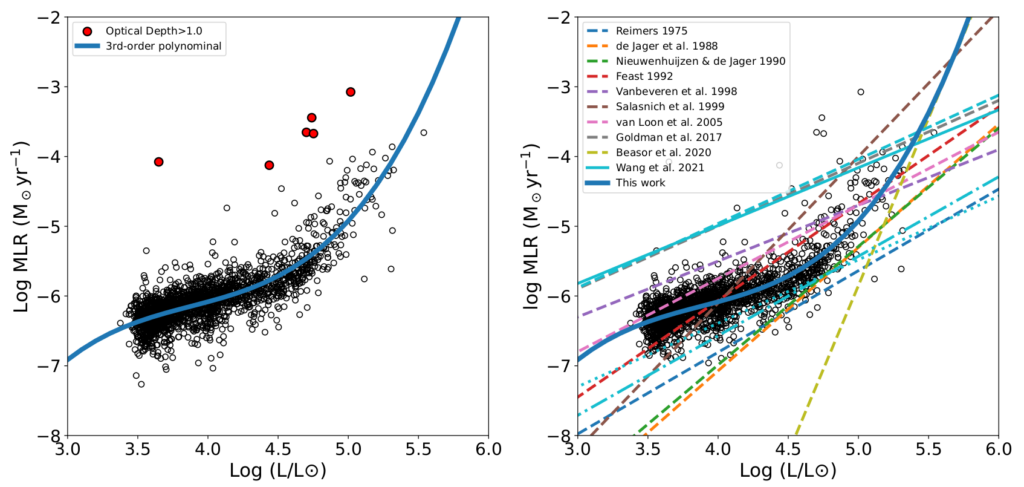Evolved Massive Stars at Low-metallicity V. Mass-Loss Rate of Red Supergiant Stars in the Small Magellanic Cloud
Ming Yang (杨明), Alceste Z. Bonanos, Biwei Jiang (姜碧沩), Emmanouil Zapartas, Jian Gao (高健), Yi Ren(任逸), Man I Lam (林敏仪), Tianding Wang (王天丁), Grigoris Maravelias, Panagiotis Gavras, Shu Wang (王舒), Xiaodian Chen (陈孝钿), Frank Tramper, Stephan de Wit, Bingqiu Chen (陈丙秋), Jing Wen (文静), Jiaming Liu (刘佳明), Hao Tian (田浩), Konstantinos Antoniadis, and Changqing Luo (罗常青)
ABSTRACT
The mass-loss rate (MLR) is one of the most important parameters in astrophysics, since it impacts many areas of astronomy, such as, the ionizing radiation, wind feedback, star-formation rates, initial mass functions, stellar remnants, supernovae, and so on. However, the most important modes of mass-loss are also the most uncertain, as we are still far from clear about the dominant physical mechanisms of the mass-loss. Here we assemble the most complete and clean red supergiant (RSG) sample (2,121 targets) so far in the Small Magellanic Cloud (SMC) with 53 different bands of data to study the MLR of RSGs. In order to match the observed spectral energy distributions (SEDs), a theoretical grid of 17,820 Oxygen-rich models (“normal” and “dusty” grids are half-and-half) is created by the radiatively-driven wind model of the DUSTY code, covering a wide range of dust parameters. We select the best model for each target by calculating the minimal modified chi-square and visual inspection. The resulting MLRs from DUSTY are converted to real MLRs based on the scaling relation, for which a total MLR of 6.16 × 10−3 M yr-1 is measured (corresponding to a dust-production rate of ∼ 6 × 10−6 M yr-1), with a typical MLR of ∼ 10−6 M yr-1 for the general population of the RSGs. The complexity of mass-loss estimation based on the SED is fully discussed for the first time, indicating large uncertainties based on the photometric data (potentially up to one order of magnitude or more). The Hertzsprung-Russell and luminosity versus median absolute deviation diagrams of the sample indicate the positive relation between luminosity and MLR. Meanwhile, the luminosity versus MLR diagrams show a “knee-like” shape with enhanced mass-loss occurring above log10(L/L ) ≈ 4.6, which may be due to the degeneracy of luminosity, pulsation, low surface gravity, convection, and other factors. We derive our MLR relation by using a third-order polynomial to fit the sample and compare our result with previous empirical MLR prescriptions. Given that our MLR prescription is based on a much larger sample than previous determinations, it provides a more accurate relation at the cool and luminous region of the H-R diagram at low-metallicity compared to previous studies. Finally, 9 targets in our sample were detected in the UV, which
could be an indicator of OB-type companions of binary RSGs.

